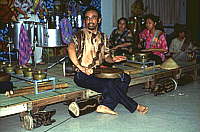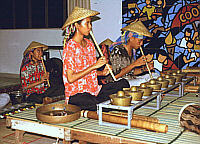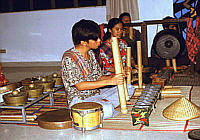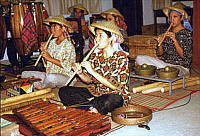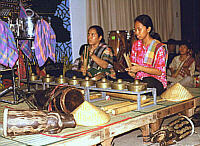College of Arts and Letters Kontemporaryong Gamelan Pilipino (KONTRA-GAPI) Filipino students of the premier University of the Philippines re-trace the journey of their national hero Jose Rizal, pride and idelolgoue of south east asian and third-world nationalism, as they journey to the places in Austria where he once stayed. Most memorable is Leitmeritz (Bohemia, now Czech Republic), the home city of his best friend, Ferdinand Blumentritt. On the occasion of the centennary of the Philippine Revolution (1896-1996) and the establishment of the very first republic in Asia (1898-1998), KONTRA-GAPI dedicates itself to the ideals of Rizal and the meaning for Filipinos and for all peoples of the world of his martyrdom. These young "cultural ambassadors of Goodwill" have dedicated themselves to re-living the significance of this event by giving of themselves trough their art based primordially on ancient asian roots.
Music Samples (WAV-Format) - Press CommentsResident Ethnic Music and Dance Ensemble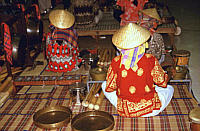 The gamelan is the quintessential orchestra of South East Asia. Africa may
lay claim to massed polyrythmic drums, Europe the symphony orchestra and the
United States, the jazz and rock bands, but no musical ensemble typifies
this part of the world - its mysticism, timelessness, grandeur, beauty and
feeling of community the way the gamelan does. The wonder of it is that
while the tradition may be shared by many cultures, each one has evolved a
style, a sense of aesthetics and a manner of presentation unique to itself
- a mirror of its people, ecology, history and lore, psychology and values.
The gamelan is the quintessential orchestra of South East Asia. Africa may
lay claim to massed polyrythmic drums, Europe the symphony orchestra and the
United States, the jazz and rock bands, but no musical ensemble typifies
this part of the world - its mysticism, timelessness, grandeur, beauty and
feeling of community the way the gamelan does. The wonder of it is that
while the tradition may be shared by many cultures, each one has evolved a
style, a sense of aesthetics and a manner of presentation unique to itself
- a mirror of its people, ecology, history and lore, psychology and values.The Kontemporaryong Gamelan Pilipino draws inspiration from this ancient and profound source nurtured and sustained by the depth, wealth and cultural diversity of the Philippines and her Asian roots. Widely identified by its acronym KONTRA-GAPI , the group strives to express music and kindred arts from indigenous well-springs, reaping from the people and giving back to them in new form " as magical as the moonlight and constantly changing as water".
The word gamelan derives from the Javanese "gamel" which means to hammer. Typically, a gamelan consists of percussion instruments such as gongs and drums of graduated sizes, wood and metal xylophones of varied timbre, flutes and whistles, assorted bamboo wooden and metal percussion and voices for singing and for expressive vocables. KONTRA-GAPI uses ideophones such as the kulintang, gangsa, tongatong and kalutang; chordophones like the hegalong, kulibet, gitgit and kuritang; aerophones such as the diwdiw-as, esmi, tonggali and suling ; and membranophones like the debakan, solibaw and Cordilleran drums of varying sizes and shapes. The human body itself through applause, stomping , chest pounding, clicking and other means turns into a producer of myriad sounds. There are, too, quaint pieces like the kuribaw or mouth harp and the tambi or zither-drum in a reserve of over a thousand instruments. The collection is more than sufficient for the ensemble which performs with as many as fifty and as few as five players. Most engagements require fifteen to twenty for a full programme.
The ensemble exists on the assumption that every human being by definition is creative singly or as part of a community. Creativity is not the exclusive preserve of 'experts' and excellence can be attained by individuals who possess varying levels of artistic ability. No auditions are held to recruit members. Any student, faculty, or worker from the university or anyone from anywhere else interested may join to discover for herself how far and how deeply she can go as an instrumentalist, a singer, an actor or mime. Each one makes a valuable contribution according to her ability under a discipline of dedication, responsibility, industry and love for the nation's cultural heritage.
Over the years, the ensemble has done some 800 shows with audiences of all types and age-groups in an assortment of venues. From the state-of- the-art theaters of the Cultural Center of the Philippines (CCP), hotel pavillons and lobbies, school auditoriums and yards and church naves and parks to make-shift stages, barangay or community all-purpose halls, basketball and other sports arena, private residences, ricefields, the streets and market places, KONTRA-GAPI has brought its art to where the people are or to where they can or choose to congregate. Some of its most notable performances include yearly participation in national holidays such as the anniversaries of the EDSA Revolution (25 February) and Araw ng Kalayaan or Independence Day (June 12). In the U.P., KONTRA-GAPI has provided music and ritual during graduation ceremonies. The CCP twice awarded the group recognition through its chamber artists series and venue-grants. Year after year the gamelan has been invited to participate in various initiatives of the National Commission for Culture and Arts. It has often been invited to represent Philippine roots, then as now, in international multi-cultural programs. In The 1992 University Athletic Association of the Philippines opening, host U.P. commissioned original live music accompaniying a full evening extravaganza for one of the most important yearly events in sports. For three consecutive anniversaries of top-rated FM station DZCT (Citylite) from 1993 - 1995, the ensemble had been featured together with some of the finest Filipino and International performers in the most celebrated annual concert program sponsored by a radio station. In all these occassions, KONTRA-GAPI has come to symbolize " diversity within unity" and "unity in diversity". Proudly, it continues to do so to this day.
The ensemble's inventions in live performances and recordings have excited the choreographic productions of proponents of wide-ranging styles of dance: The Adrenalin Dancers, Ballet Manila , Ballet Philippines, Chameleon Dancers , Dancers Inc., the Maneouvres, Solid Gold Dancers, Powerdance , the U.P. Filipiniana Dance Group, VIP Dancers , and Whiplash. Some of the most highly esteemed choreographers such as Osias Barroso, Joy Coronel, Ianne Damian, Agnes Locsin, Jojo Lucila, Douglas Nierras and Edna Vida have been inspired by KONTRA-GAPI's music to compose original spirit-stirring works. The group has provoked fusion innovations with small and large musical ensembles of varying categories and styles : Bela Fleck and the Flecktones (jazz) , Jazz Fiesta, The Philippine Philharmonic Orchestra under the direction of foremost composer Ryan Cayabyab, Powerplay (Rock/Pop band), Rumba Calzada (Latin conjunto) and the Wuds (Rock band). Some of the most moving experiences of the gamelan artists have to do with sharing and co-creating in solidarity with indigenous peoples from the Cordilleras, the Sierra Madres, Mindoro, Panay, Palawan and Central and Western Mindanao.
The group has appeared as guest in major musical variety programs on nationwide radio and television coverage such as " A Little Night of Music", "Concert at the Park", "Eat Bulaga", "Paco Park Presents", "R.S.V.P.", "Sa Linggo nAPO Sila", "Sang Linggo nAPO Sila", " Vilma in Person", the anniversaries of Channels 5 and 13 and a slew of specials. For a while KONTRA-GAPI artists and music served as time marker for Channel 5. The PDCP Bank commercial for print, radio and T.V. was made with the ensemble contributing the original music, the models, and actors. The gamelan has produced and released two cassette albums: "World Beat / World Music - Filipino" and "Gong at Ritmo, Lunggating Pilipino". Selections from this album have been used to score stories on culture, the arts of the nation, indigenous peoples and the environment in public affairs and magazine programs on radio and television such a the "Probe Team", "5 and Up", "Pinoy Eh!" and "Travel Time" all on GMA (Channel 7) and "Inside Story" (Channel 2). These programs have featured the story of KONTRA-GAPI as magazine segment. The group is due to release its first compact disc in 1997. The ensemble has gone on road tour to Baguio City and the Cordilleras, the provinces of Bataan, Cagayan, Cavite, Ilocos Sur, Laguna, Nueva Ecija, Pampanga, Rizal, Tarlac, Quezon, and Zambales. Between April and October in 1997 , the group is scheduled to go on a concert tour to Austria, Belgium, France, Germany, Italy, the Netherlands, Spain, the United Kingdom in Europe, the United States and Canada upon the invitation of festival organizers, government bureaus, Philippine diplomatic missions, Filipino and International organizations and friends.
See also:
|
| [Austrian-Philippine Homepage] [Culture and History] [Kontra-Gapi] |
|
Document created: February 15, 1997 updated: June 12, 1998 APSIS Editor Johann Stockinger |
